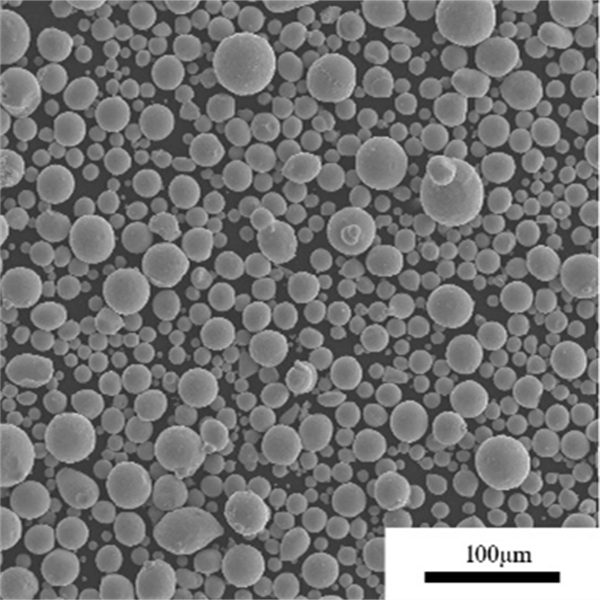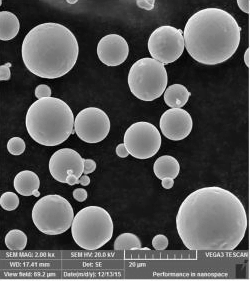
Best Stainless Steel 316L Powder for 3D Printing
Overview of Stainless Steel 316L Powder 316L stainless steel belongs to the austenitic class of stainless steels. The addition of 2-3% molybdenum along with nickel and chromium imparts excellent pitting and crevice corrosion resistance in harsh environments. The ‘L’ denotes lower carbon content to avoid carbide precipitation during welding. Key characteristics of 316L powder include:…
ขั้นต่ำขนาดเล็ก
Flexible sourcing for hundreds of products
Customization support
Customized powder according to industry
Rapid shipment
By DHL Express, safe and fast direct to your hands
Overview of Stainless Steel 316L Powder
316L stainless steel belongs to the austenitic class of stainless steels. The addition of 2-3% molybdenum along with nickel and chromium imparts excellent pitting and crevice corrosion resistance in harsh environments. The ‘L’ denotes lower carbon content to avoid carbide precipitation during welding.
Key characteristics of 316L powder include:
- Excellent corrosion resistance in harsh environments
- High oxidation and sulfidation resistance at elevated temperatures
- Very good weldability and formability
- Non-magnetic austenitic structure
- Available in range of particle size distributions
316L powder is suitable for applications requiring excellent corrosion resistance like chemical processing, pharmaceutical, food and beverage, marine equipment and biomedical implants. This article provides a detailed overview of 316L powder.
Chemical Composition of 316L Powder
The typical composition of 316L powder is:
| องค์ประกอบ | เปอร์เซ็นต์น้ำหนัก |
|---|---|
| เหล็ก (Fe) | สมดุล |
| โครเมียม (Cr) | 16-18% |
| นิกเกิล (Ni) | 10-14% |
| โมลิบดีนัม (Mo) | 2-3% |
| แมงกานีส (Mn) | ¨P 2% |
| ซิลิคอน (Si) | ¨P 1% |
| คาร์บอน (C) | ¨P 0.03% |
| ฟอสฟอรัส (P) | ¨P 0.045% |
| กำมะถัน (S) | ¨P 0.03% |
Nickel enhances corrosion resistance while molybdenum addition improves resistance to pitting and crevice corrosion in environments containing chlorides. Low carbon content avoids carbide precipitation during welding.

Properties of 316L Powder
316L powder possesses the following properties:
| ทรัพย์สิน | มูลค่า |
|---|---|
| ความหนาแน่น | 7.9-8.1 g/cm3 |
| จุดหลอมเหลว | ค.ศ.1370-1400 |
| การนำความร้อน | 16 W/mK |
| ความต้านทานไฟฟ้า | 0.75 Ã×´Î.cm |
| โมดุลัสหนุ่ม | 190-210 GPa |
| อัตราส่วนปัวซอง | 0.27-0.30 |
| ความแข็งแรงเชิงดึง | 485-620 MPa |
| จุดคราก | 170-310 MPa |
| การยืด | 40-50% |
| ความแข็ง | 79-95 HRB |
316L offers excellent corrosion resistance combined with good formability and weldability. The austenitic structure provides good toughness and ductility.
Production Method for 316L Powder
Common production methods for 316L powder include:
- การแปรสภาพเป็นอะตอมของแก๊ส?- Inert gas jets disintegrate molten 316L alloy stream into fine spherical powders with controlled size distribution.
- การทำให้ละอองน้ำกลายเป็นไอ?- High pressure water jet impacts and disintegrates molten metal to produce fine irregular powder particles.
- การหลอมแบบเชิงกล? - การบดบอลของผงธาตุที่ผสมกันตามด้วยการเผาและการทำให้เป็นละอองอีกครั้ง
Gas atomization allows excellent control over particle characteristics like size, shape, oxygen pickup and microstructure.
Applications of 316L Powder
Typical applications of 316L powder include:
- การผลิตแบบเติมเนื้อ?- Powder bed fusion, binder jetting processes use 316L powder for chemical, marine, biomedical parts.
- การฉีดขึ้นรูปโลหะ?- To manufacture small, complex components needing corrosion resistance.
- การพ่นสารเคลือบความร้อน?- Wire arc spray deposition to produce protective coatings in harsh environments.
- วัสดุสิ้นเปลืองสำหรับเชื่อม?- Used as filler material for joining 316L components providing excellent weld strength.
- กระบวนการทางเคมี?- Powder metallurgy vessels, trays, baskets used in chemical and pharmaceutical industries.
Specifications of 316L Powder
316L powder is available under different size ranges, shapes and purity levels:
- ขนาดของอนุภาค:?From 10-45 Ã×m for AM methods, up to 150 Ã×m for thermal spray processes.
- ลักษณะ?Spherical, irregular and blended particle shapes. Smooth spherical powder provides optimal flow.
- ความบริสุทธิ์:?From commercial to high purity (99.9%) tailored to application requirements.
- ปริมาณออกซิเจน:?Levels maintained at 100-1000 ppm for most applications.
- Flow Rate:?Powder customized for flow rates above 25 s/50 g.
Global Suppliers of 316L Powder
Some of the major global suppliers of 316L powder include:
- Sandvik Osprey (สหราชอาณาจักร)
- โฮกานัส (สวีเดน)
- Carpenter Powder Products (USA)
- Praxair (USA)
- Oerlikon Metco (Switzerland)
- LPW Technology (UK)
These companies produce various grades of 316L powder tailored for additive manufacturing, thermal spray, metal injection molding and other applications.
Pricing of 316L Powder
316L powder prices depend on factors like:
- ระดับความบริสุทธิ์
- ลักษณะอนุภาค
- ปริมาณการสั่งซื้อ
- การประมวลผลเพิ่มเติม
- ผู้ผลิตและสถานที่ตั้งทางภูมิศาสตร์
| เกรด | ช่วงราคา |
|---|---|
| โฆษณา | 15-25 บาทต่อกิโลกรัม |
| ความบริสุทธิ์สูง | 25-50 บาทต่อกิโลกรัม |
| Ultrafine | 50-120 บาทต่อกิโลกรัม |
| เกรดพิเศษ | กิโลกรัมละ 120-250 บาท |
Gas atomized, controlled particle size, high purity powders command much higher pricing over regular commercial grade 316L powder.
Storage and Handling of 316L Powder
316L powder should be handled with care to:
- Prevent contact with moisture, acids etc. leading to corrosion
- Avoid fine powder accumulation to minimize risk of dust explosions
- Use proper ventilation, PPE when handling fine powders
- Follow recommended practices from supplier SDS
- Store sealed containers in a dry, inert atmosphere
Proper protective measures must be taken when handling reactive alloy powders like 316L.
Inspection and Testing of 316L Powder
Key quality control tests performed on 316L powder:
- วิเคราะห์ทางเคมีโดยใช้ OES หรือ XRF เพื่อให้มั่นใจว่าองค์ประกอบต่างๆ อยู่ในขีดจำกัดที่กำหนด
- การกระจายขนาดของอนุภาคตามมาตรฐาน ASTM B822
- การวิเคราะห์สัณฐานวิทยาผ่านภาพ SEM
- Powder flow rate measured as per ASTM B213 standard
- การกำหนดความหนาแน่นโดยการหาปริมาตรด้วยฮีเลียม
- การทดสอบหาสิ่งเจือปนโดย ICP-MS
- Microstructure characterization by X-ray diffraction
Thorough testing ensures the powder meets the required chemical, physical and microstructural characteristics for the intended application.
Comparison Between 316L and 304L Stainless Steel Powders
316L and 304L stainless steel powders compared:
| พารามิเตอร์ | 316L | 304L |
|---|---|---|
| องค์ประกอบ | Fe-Cr-Ni-Mo | Fe-Cr-Ni |
| ความต้านทานการกัดกร่อน | ดีขึ้นเยอะเลย | ดี |
| ค่าใช้จ่าย | สูงขึ้น | ลดลง |
| Temperature resistance | ดีกว่า | ดี |
| ความสามารถในการเชื่อม | ยอดเยี่ยม | ยอดเยี่ยม |
| ความพร้อมใช้งาน | ปานกลาง | ยอดเยี่ยม |
| แอปพลิเคชัน | Marine, chemical industry | Consumer products, appliances |
316L offers substantially better corrosion resistance whereas 304L is more economical for less demanding applications.
316L Powder FAQs
Q: How is 316L stainless steel powder produced?
A: 316L powder is commercially produced using gas atomization, water atomization and mechanical alloying followed by sintering. Gas atomization offers the best control of powder characteristics.
Q: What are the main applications of 316L powder?
A: Key applications for 316L powder include additive manufacturing, metal injection molding, thermal spray coatings, and powder metallurgy parts for chemical, marine, pharmaceutical and food industries needing excellent corrosion resistance.
Q: What is the recommended 316L powder size for binder jetting AM?
A: For binder jetting process, the typical 316L powder size range is 20-45 microns with spherical morphology for optimal powder bed density and binder infiltration.
Q: Does 316L powder require special handling precautions?
A: Yes, 316L is a reactive alloy powder and should be handled carefully under controlled humidity and inert atmosphere using proper grounding, ventilation and PPE.
Q: Where can I buy 316L powder suitable for biomedical implants?
A: High purity, gas atomized 316L powder meeting biomedical specifications can be purchased from leading manufacturers like Sandvik Osprey, Hoganas, Carpenter Powder Products and LPW Technology.
Contact us now
Please contact us for recent product quotes and stock availability.
